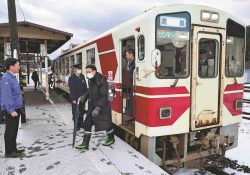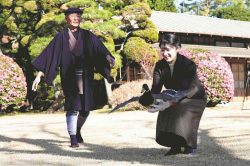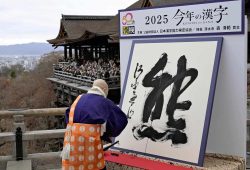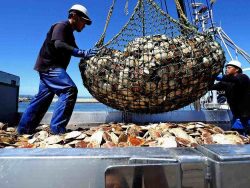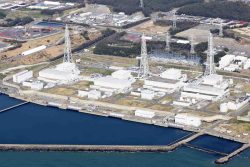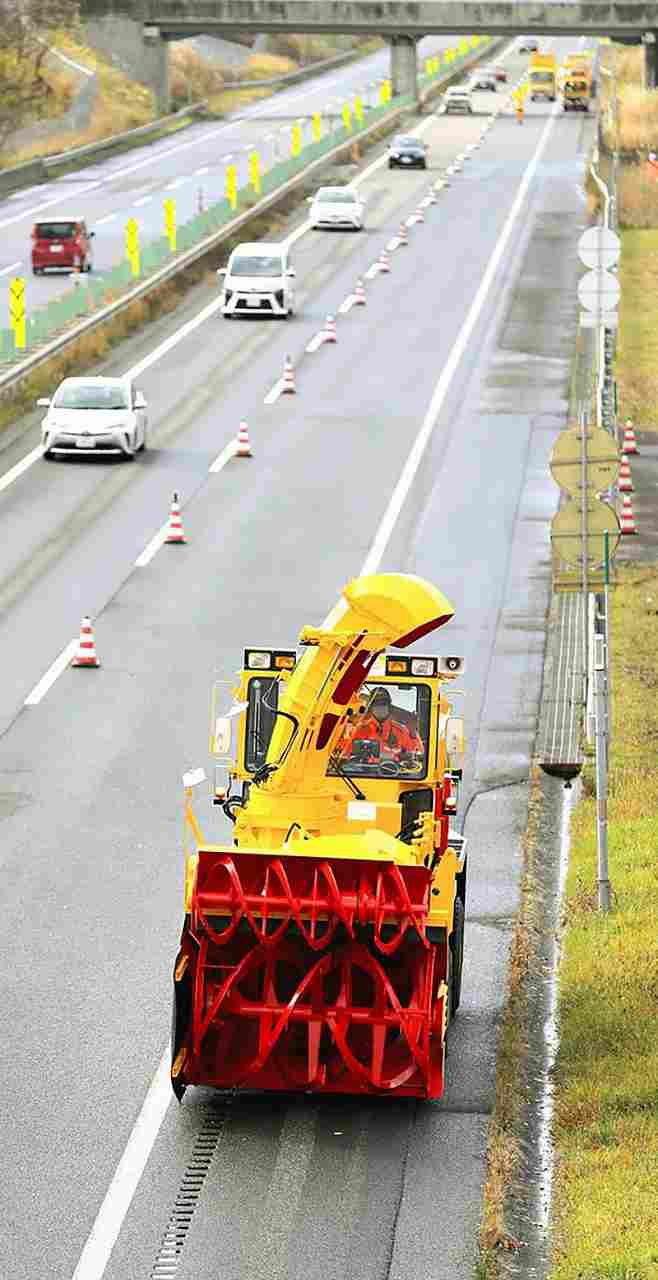
A self-driven snow-removal vehicle operates by using positioning information from satellites in Iwamizawa, Hokkaido, on Nov. 17.
December 10, 2021
Passengers stuck in stranded cars on snowy highways may soon have new sources of help — satellites and artificial intelligence.
Snow-clearance workers have been growing older and the supply of labor for the job has been growing smaller, but the innovative use of technology may help keep traffic flowing and facilitate rescues, thus preventing incidents in which people die inside of cars buried in snow.
Visibility no issue
On Nov. 17, the prototype of a self-driving snow removal vehicle about 8 meters long and 2 meters wide made an experimental demonstration run on the Do-o Expressway in Iwamizawa, Hokkaido. Operator Minoru Matsuda, 40, said, “Even when visibility becomes very low in drifting snow, work can be done safely if this automation is realized.”
East Nippon Expressway Co. is developing the vehicle. The goal of the project is to produce self-driving vehicles for snow removal that do not need to be controlled with steering wheels and accelerators.
The technology relies on Japan’s Michibiki quasi-zenith satellite system, which provides precise positioning information.
The satellite system’s margin of error is said to be only a few centimeters. By combining the satellite information with road information in devices installed in the snow-removal vehicles, the vehicles can accurately follow roads even in low visibility.
Automation is also being studied for the vehicles’ snowblowers. If this is realized, the number of crew members required to operate a snow-removal vehicle, which is currently two — one to drive the vehicle and one to control the snowblower — will be reduced to one, who will be needed only in the event of an emergency.
An official of East Nippon Expressway said, “It will become possible for fewer workers to thoroughly clear away the snow.” The company aims to put the vehicle into practical use as early as fiscal 2023.
Graying workforce
Large-scale strandings of cars in snow have occurred almost every year.
In December last year, a large number of vehicles were stranded in a deep accumulation of snow on the Kan-etsu Expressway in Niigata Prefecture. Traffic came to a standstill in both directions, with a total of about 2,100 vehicles unable to move. It took nearly two days to resolve the problem.
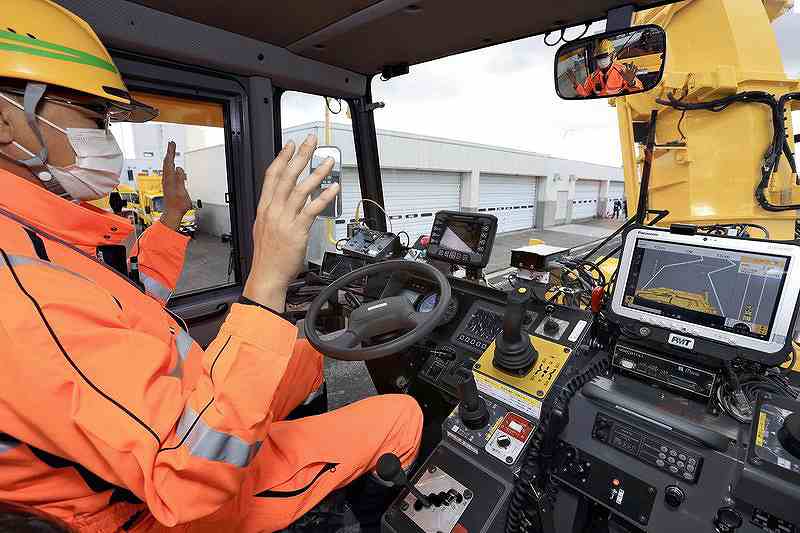
A driver lifts his hands from the steering wheel while a self-driving snow-removal vehicle runs.
In Fukui Prefecture in February 2018, several cars were stranded in snow. Inside one, a 19-year-old man died of carbon monoxide poisoning while waiting for rescue after the car’s exhaust pipe became buried in snow.
Meanwhile, skilled snow-clearance workers who are capable of handling such cases have been rapidly aging.
According to the Hokkaido Regional Development Bureau of the Land, Infrastructure, Transport and Tourism Ministry, the number of participants in training sessions for snow-removal machines held in Hokkaido last fiscal year was 1,401, which is 40% less than 15 years ago.
During the same period, the percentage of participants age 60 or older rose from 5.4% to 18.8%.
“Many snow-clearance workers are also construction workers in their areas, and all of the areas face the problems of labor shortages and rising ages of workers,” an official of the ministry said.
Quick detection
The ministry will introduce monitoring of road conditions with cameras and artificial intelligence starting this winter. It aims to quickly detect stranded vehicles and prevent initial trouble from becoming more serious.
The AI program automatically detects vehicles that have made unnatural moves, such as sudden stops or swerves that might indicate attempts to avoid obstacles. Then the AI program forwards the information to road management officials.
The AI program is intended to quickly rescue people from accidents and strandings that could obstruct traffic flows, and to prevent such trouble from compounding.
Currently, there are about 15,000 cameras used to monitor road conditions on national roads, which are managed by the government. The ministry aims to introduce AI-equipped cameras in areas with steep grades and sharp curves as priority sites.
There are also movements in the private sector to utilize AI for the same purpose.
One is a system to automatically analyze snow conditions on road surfaces, which was developed by Weathernews Inc., a weather information service company.
The AI program, which has learned to recognize visual data of snow-covered road surfaces, analyzes and designates the road conditions into such categories as dry, accumulated snow, compacted snow or slush, and then displays them as patterns in different colors.
Observers can then see whether road surface conditions have worsened or improved, and how they have changed.
Some expressway management companies began introducing the system this month.
Much snowfall predicted
According to the Japan Meteorological Agency, snowfall this season will likely be at or above average-year levels, mainly in regions facing the Sea of Japan.
Due to effects from the La Nina phenomenon, in which the sea surface temperatures around the equator in the eastern Pacific remain lower than normal, it is easier for cold air masses to flow into areas in and around western Japan.
Amounts of snowfall in western Japan are predicted to be larger than in average years, those in eastern Japan will be at or above average-year levels, and those in northern Japan will be almost the same as in average years.
"Society" POPULAR ARTICLE
-

M4.9 Earthquake Hits Tokyo, Neighboring Prefectures
-

M7.5 Earthquake Hits Northern Japan; Tsunami Waves Observed in Hokkaido, Aomori and Iwate Prefectures
-

Tsukiji Market Urges Tourists to Avoid Visiting in Year-End
-

Israeli Tourists Refused Accommodation at Hotel in Japan’s Nagano Pref., Prompting Protest by Israeli Embassy and Probe by Prefecture
-

Beloved Cat Stationmaster Nitama in Wakayama Pref. Passes Away at 15
JN ACCESS RANKING
-

Keidanren Chairman Yoshinobu Tsutsui Visits Kashiwazaki-Kariwa Nuclear Power Plant; Inspects New Emergency Safety System
-

Imports of Rare Earths from China Facing Delays, May Be Caused by Deterioration of Japan-China Relations
-

Japan Exports Rise in October as Slump in U.S. Sales Eases
-

Japan Pulls out of Vietnam Nuclear Project, Complicating Hanoi’s Power Plans
-

Govt Aims to Expand NISA Program Lineup, Abolish Age Restriction



